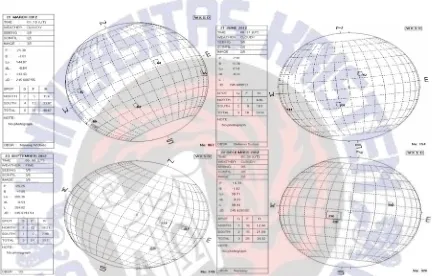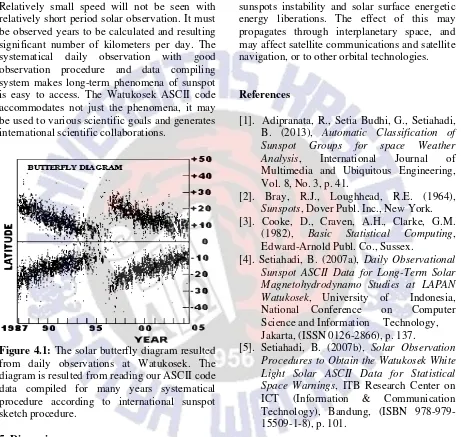SOLAR PHYSICS LONG TERM RESEARCH RESULT:
THE BUTTERFLY DIAGRAM OF ACTIVE REGIONS
Bambang Setiahadi
Indonesian National Institute of Aeronautics and Space (LAPAN) Watukosek, Gempol P.O. Box 04, Pasuruan 67155
[email protected]; [email protected]
ABSTRACT
Solar activity daily monitoring at Watukosek Solar Observing Site at Watukosek, East Java, has resulted important solar activity regions mapping. The mapping is coded internationally as Solar Butterfly Diagram. This result demonstrated a capability of Watukosek in conducted international-coordinated solar activity observations. The results may be extracted by our ASCII data base and flexibly might be used for multiyear researches.
Keywords: Daily observations, ASCII code, Butterfly Diagram
1. Introduction
Scientific results from solar physics research have proven its utility to human life. It is not surprisingly that more research institutions and universities are gradually being involved to solar physics researches and observations. Various hardware or software-based solar physics technology, as solar active battery cells and solar pond generators for small scale electricity, is proved to be more environment friendly technology.
The solar research needs continual and consistent observational activity, based-on everyday coordinated solar international standard observation procedure with other solar observatory through-out the world [4]. It is worth than after decades international coordinated observations that our star, the Sun, hides many plasma physics interactions as periodic phenomena, ranging from minutes to hundred year periodicities.
Since the observatory is located near equator at about 07034S and
112
040
!E
, observation only face the tropical dry and rainy seasons in a year. The chances to observe the sun under clearsky condition is abundant compare to four-season observation, and consequently the data is huge. Even we make only one report in a day; the data we compile in a year is around 365 or 366 reports. This is about two times larger than four seasons report’s observatory.
Nearly everyday we have a report as an output from our sunspot telescope. Beside conventional sunspot reports in a piece of a paper, we consider to construct an ASCII data format and compile the year’s data in very compact manner. Scientist, who needs to look out the data from certain day of observations, may have it immediately without look out the original data. Our original data is opened when we consider it is necessary to look the original configuration of sunspot and its heliographic position.
2. Observations
sun light rays and radiation. Protective filter as well as operation procedure has to be innovated to make safe solar observations.
In case white light sunspot digital observations, with direct image method, the telescope has to apply a neutral filter to reduce sun light intensity [2]. Practically one has to reduce the sun light intensity as low as 10-6 times to original intensity. More over, to reduce stray lights, a green filter has to be added in front of a digital sensor. Those two apparatuses generally comply to convey safe observation to both over-all hardware’s and with observer.
Our solar observations activity has international collaborations and consequently international procedure must be adopted. There are several parameters in conjunction with sunspot white-light observations. The very first is it conveys international sunspot-sketch using B4 size white-paper with good quality and withstand against local humidity for more than 50 years ahead. Good filing system with only special staff could reach and accessed original data [5].
The second is the international time keeping that keeps a clock at a solar observatory ticking until accuracy within 10-1 second. This is the only parameter connect among one observatory to other international observatory, that is why every observer has deep concern with time coordinate. International coordinated observation applies the Greenwich Mean Time (or GMT) as international time coordinate. Other so-called is Universal Time Coordinate (UTC). The Watukosek Solar Observatory has 7+UTC in its time coordinate.
The third is carefully notes environmental and local weather every time an observation is done. The parameters are related to atmospheric transparency that could affect the sunspot counting, there are seeing, scintillation, and image stability. After all those parameters are noted carefully, observation of sunspot is starting and ending with precise UTC time recorded at the start and ending. The presume time coordinate at the observation is half of
starts and ends time coordinate. The lastly procedure to fulfill is East-West direction on sunspot sketch. This direction is a line across sunspot sketch paper to serve as fundamental line to solar actual equator and North-South direction of true solar pole.
3. Method and Processing
Soon after the international procedure produces a sunspot sketch data, further sequential procedure to convert the data to be more scientifically valuable. The sequential procedure has final results at least two kinds of data, a conventional paper sunspot sketch data and ASCII code. The paper sketch provides international data compiling as a continuation of 400 years international solar observations. While the ASCII sunspot sketch data provides quick access and may be further used for statistical or long term solar physics researches [3].
The important slot to determine solar surface phenomena such as the sunspots, is carefully determined the orientation of solar globe seen relative from an observer on earth [2]. This provide by carefully determine the equatorial angle of North-South and East-West direction. Tensorial heliographic coordinate system and procedure developed in Watukosek Solar Observatory uses the previously mention procedure as initial data to guarantee the uniqueness one-to-one correspondence of sunspot coordinate on solar surface.
rotation in a period of 27 days along its equator; coded as L.
The ASCII code of our sunspot sketch data includes all parameters give necessary information of every day report on UTC time of observation, date-month-year of observation, weather condition, celestial angel P, B, and L;
observer’s name, number of sheet, and sunspot counting number R, f, and g. One may read-out ASCII data and makes suitable programming according to one’s capability and scientific objectives. One of that is the famous solar Butterfly Diagram.
Figure 3.1: Output of ASCII-coded for four seasons extreme in March, June, September, and December 2012. The important notes can be read on the left side of the report, and the orthographic two dimensional projection of solar disk with sunspots and active regions positions and numbering systems are obvious.
4. Result
Modern observations reveal important and interesting reality that the sun rotates on its axis exhibits non-massive celestial body as its planets. Instead, the sun rotates differentially that proven all material building up the solar globe is fluid rather than solid. The density of the fluid is about the same order with water density.
The sun keeps its high temperature body, at least on the surface is no less than 60000 Kelvin. This
is the reason why all material of the sun should be in sub-atomic and dynamical state. From spectral observations the sun consist of most abundance electrons, followed by protons or hydrogen nucleus, and ions.
longitudinal and at the same time latitudinal flow components. On the average the sunspots have resultant speed on solar surface no less than 10km/day.
Relatively small speed will not be seen with relatively short period solar observation. It must be observed years to be calculated and resulting significant number of kilometers per day. The systematical daily observation with good observation procedure and data compiling system makes long-term phenomena of sunspot is easy to access. The Watukosek ASCII code accommodates not just the phenomena, it may be used to various scientific goals and generates international scientific collaborations.
Figure 4.1: The solar butterfly diagram resulted from daily observations at Watukosek. The diagram is resulted from reading our ASCII code data compiled for many years systematical procedure according to international sunspot sketch procedure.
5. Discussions
Further work may be directed to many ways depending on scientific focus or goal. Study for systematical motion of sunspots in years generate solar sunspot statistical study [1]. The results of the study provide solar differential curve which can be applied into solar energy
dynamo generates from non-linear dynamo processes below observable solar surface.
Inner study from solar deeper layers might open the discovery of very initial process of solar sunspots instability and solar surface energetic energy liberations. The effect of this may propagates through interplanetary space, and may affect satellite communications and satellite navigation, or to other orbital technologies.
References
[1]. Adipranata, R., Setia Budhi, G., Setiahadi, B. (2013), Automatic Classification of Sunspot Groups for space Weather Analysis, International Journal of Multimedia and Ubiquitous Engineering, Vol. 8, No. 3, p. 41.
[2]. Bray, R.J., Loughhead, R.E. (1964), Sunspots, Dover Publ. Inc., New York. [3]. Cooke, D., Craven, A.H., Clarke, G.M.
(1982), Basic Statistical Computing, Edward-Arnold Publ. Co., Sussex.
[4]. Setiahadi, B. (2007a), Daily Observational Sunspot ASCII Data for Long-Term Solar Magnetohydrodynamo Studies at LAPAN Watukosek, University of Indonesia, National Conference on Computer Science and Information Technology,
Jakarta, (ISSN 0126-2866), p. 137.
[5]. Setiahadi, B. (2007b), Solar Observation Procedures to Obtain the Watukosek White Light Solar ASCII Data for Statistical Space Warnings, ITB Research Center on ICT (Information & Communication Technology), Bandung, (ISBN 978-979-15509-1-8), p. 101.
Appendix
one-to-one correspondence algebraic set theory, as well as unique transformation.
Repeated upper and lower indexes are applied the Einstein-ian summation rule that is usually implemented in special or general relativity physics for celestial body, such as the Sun, Planets, Stars, and Galaxies

